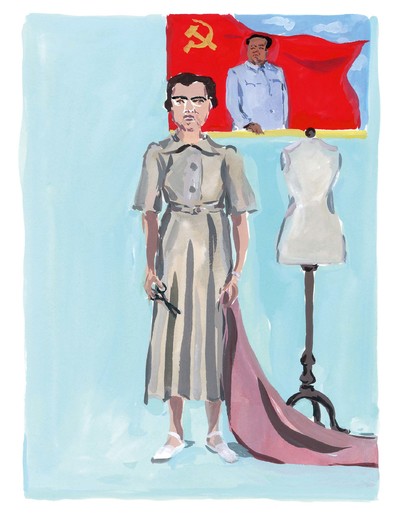Taking a stand against Mao with a dress.
By Hung Huang
Illustration by Jean-Philippe Delhomme
Taking a stand against Mao with a dress.

I am Chinese – at least, I was born Chinese, in 1961. That year, wearing a dress was all the rage. Especially the boo-la-gee, which was how we pronounced платье, the Russian word for dress. This one in particular was a shirt-dress – with button fastenings on the top half, just like a shirt, and a gathered skirt from the waist. This is my first fashion memory. My grandparents used to take me to the parks around Tiananmen Square, and I remember all the girls in their boo-la-gee twirling around to see whose skirt could make a bigger shadow in the sun.
By the time I was in primary school in 1968, the Cultural Revolution was in full swing and no one was wearing a boo-la-gee anymore; it had become the wardrobe of the ‘stinking Soviet revisionists’. The fashion became instead to get army-surplus clothes and pin as many Mao badges on them as possible. When I was in first grade, small Mao badges were in, but they grew bigger and bigger until eventually our baggy uniforms were weighed down with them. Those were crazy years, with midnight parades to celebrate a new speech from the Chairman, and loudspeakers blasting his latest quotes, with everyone marching in their Mao-badge-pinned uniforms. It was like North Korea is now.
By the time I was sent to boarding school in 1970, Mao badges were ‘so last season’, but army surplus was still all the rage. Particularly the real deal, which you could tell apart from replicas with the badges. The real ones had special badges. The cool kids in my class were army brats, with real uniform hand-me-downs from their fathers.
In 1973, I was sent to New York by the Chinese government to study English. To show my staunch patriotic stance, I was determined to wear my army greens over there. But I was told that Westerners already thought the Chinese were poor, so we should get extremely dressed up to show them how well-off China really was. Twenty-eight of us were sent to different countries, and we all received a huge clothing stipend. We made fancy suits for ourselves. I remember getting a dark-red pleated skirt and a light-blue woollen coat.
Unfortunately, the most awkward things on our first day at the Little Red School House were our crisp new suits and patent-leather shoes. I swear we would have fitted in better in our army surplus, so we quickly ditched the fancy clothes and ran to The Gap for our first pair of jeans. Mine weren’t jeans, though. Instead, I got two pairs of corduroy bell-bottom pants – one in burgundy, one in sky blue.
While I was strutting around in bell-bottoms in Greenwich Village, fashion was changing at home. Jiang Qing, Mao’s wife tweaked the Russian dress, giving it an empire waist and making it pleated instead of gathered, and swapping the button-front for a Chinese crossover fold. She was very proud of her design, apparently. My mother, the wife of the foreign minister in the 1970s, was called to visit Mao’s wife at two in the morning. “I designed a dress!” Madame Mao ecstatically told her and three other sleepy ministers’ wives.
My mother recalled later that Jiang Qing wanted all foreign ministry personnel to wear the dress, and that my mother and the other wives had to wear it as an example for others. She said that even though it was the middle of the night, tailors were on standby to cut the dresses immediately. ‘Did you wear it?’ I asked her. ‘No,’ she said. I asked if it was dangerous not to wear Madame Mao’s dress. ‘Yes,’ she replied, ‘but you have to make a stand somewhere.’
And there it was, my mother’s political rebellion – all tied up in a dress.
After going to America, my fashion memory merged with the mainstream, and it stopped being unique. In the 1980s, Pierre Cardin came to China and introduced Western fashion to the Chinese. In the 1990s, China became the garment factory of the world and Chinese cities were flooded with counterfeits of Western brands. And, with their arrival, Chinese fashion disappeared.